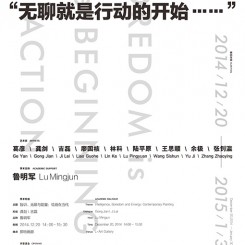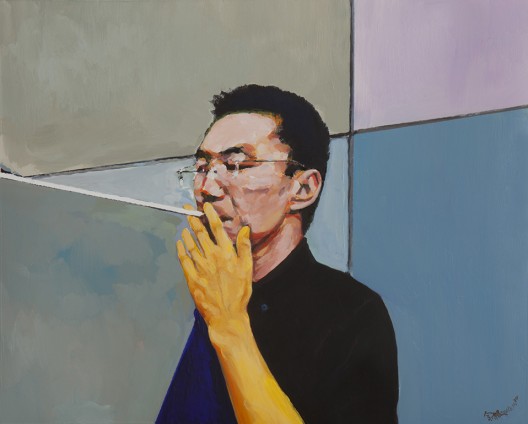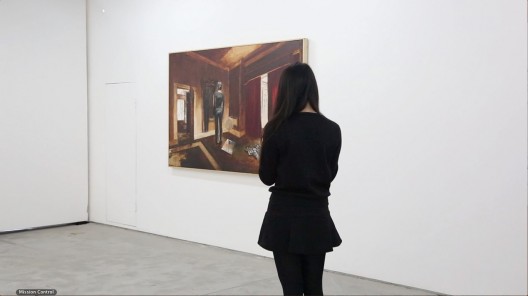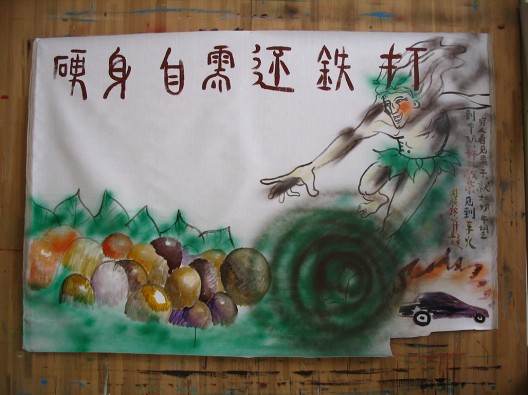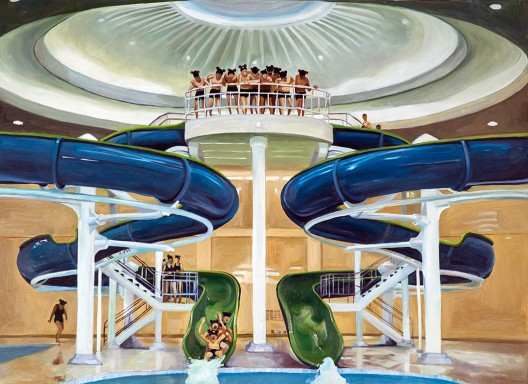Boredom is the Beginning of Action
L-Art Gallery (Area C1, Tianfu Software Park, Tianfu Avenue, Chengdu), Dec 20, 2014 – Jan 30, 2015
The title of this nine-person group exhibition is taken from Slavoj Zizek’s proposition that boredom is the beginning of every authentic act. “Without boredom,” he says “no creativity. If you are not bored, you just stupidly enjoy the situation in which you are. It is boredom that opens new career space.” Here, however, the creative efforts on show continue to reflect their usual creative processes—the result of action, rather than the foreshadowing thereof.
Clearly, Lu Mingjun had good intentions; his exhibition foreword repeatedly emphasized the word “beginning” over “boredom”. He believes boredom is a sign of the coming revolution, because when a condition has persisted beyond transformation and climax to a state of idleness—a state without any sense of novelty or possibility—its sedimentation becomes fertile soil for new changes. This small group exhibition of nine artists’ work was meant merely to be a catalyst, a fuse, a parting shot—an aggregate of numbers insufficient to constitute a phenomenon and a sample too small to search for commonalities. What’s significant lies not in the artists, or the pieces on show, but in the title, which encapsulates the curator’s dissatisfaction with the status quo. With the art world in China today, which is already in a state of “boredom” (or even “senselessness”; wuliao), the curator believes that not only has “revolution” not even entered the picture, but there is in fact little sign even of something so simple as “action”.
By introducing this perspective and expanding upon it through an exhibition, and thereby raising questions and awareness, perhaps the curator hoped this expected turmoil would find a catalyst.
The last revolution in art happened half a century ago, and to artists today, it may seem a distant past. Artists are no longer satisfied with working and reworking the microcosmic games—the “post-XXX”, “anti-XXX”, or “neo-XXX”—on the basis of concepts from the past. The idea of a new revolution remains attractive within the popular imagination, and the “exposition on boredom” prompted in Lu Mingjun’s exhibition is simply a new approach to the same idea.
Unfortunately, most of the pieces on show do not display this state; instead, they concentrate on interpretations of “boredom” [wuliao]. How, then, do the artists approach this? With a mixture of flashiness, an affected stillness in order to avoid flashiness, and “action in the guise of inaction”. Yu Ji—the male artist who is the oldest in the exhibition—chose the most direct approach. Usually appearing in performance-related venues, in this exhibition, the artist chose to show two small oil paintings. The first is a portrait of Lu Mingjun smoking a cigarette, and the other is a left hand giving the viewer the middle finger. These images (untitled) could be applied to any theme for any contemporary exhibition under any context whatsoever. Yu Ji’s understanding of “boredom” is thus quite subtle, but it also stops at boredom—any possibility of more is dissolved within the overpowering present.
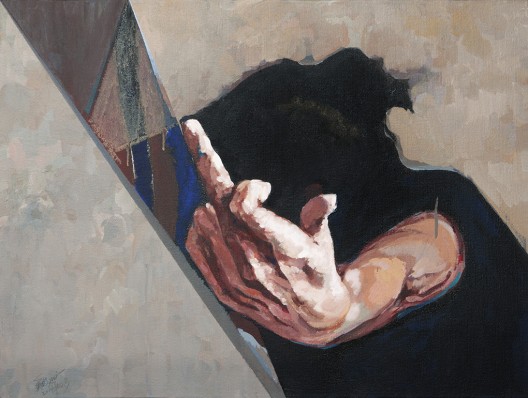
Yu Ji, “Un-fucking Believable”, acrylic on canvas, 60 × 80 cm, 2014
余极,《真他妈难以置信》,布面丙烯,60 × 80 cm,2014
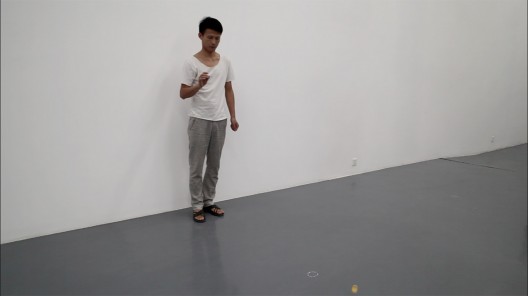
Wang Sisun, “Desire And One of N points”, Installation, performance, video, 2012
王思顺,《欲望又n分之一》,装置、行为、录像,16×8×2cm,2012
Wang Sishun’s work is a video piece showing the same action repeated in a loop: a hand lobbing an object over and over again towards a circular outline on the floor (most of the shots do not make it into the circle). Unintentional actions do not equal “boredom”; boredom leads towards frustration, towards an empty outlook where “everything is meaningless and pointless”. Yet Wang Shishun’s piece features a commonly seen technique of “intensification through repetition” used to trigger anxiety, speculation and other feelings of discomfort in the viewer. It is oriented towards actual emotions; these emotions are not the starting point of action, but the result.
The two other video works by Lin Ke and Lu Pingyuan do not take the concept any further than Wang Sishun. Lin Ke’s piece is also a form of intensification through magnification; the artist has magnified and frozen simple operations such as “editing” or “deleting” on a computer screen, bringing viewers to a state of anxiety by looping and lengthening the passage of time. This is more in line with the popular concept of boredom. For example, videos found online often have titles like, “as a boring person, I actually watched this for 20 minutes”. However, the starting point for such actions is curiosity, and an anticipation of novelty. Lu Pingyuan’s “Story Series” is an adaptation of “indecent” anecdotes. The two artists’ thought processes both find origin in the deconstruction of and rebellion against traditionally grand themes, a sort of “countercultural” backtracking, and a mere symptom of the invisible anger typical of an extended adolescence.
Ji Lei, Liao Guohe, Zhang Zhaoying and Ge Yan’s pieces for this exhibition have little to do with the show’s theme. The artists continue to expand on their own themes, which are only somewhat related to the definition of “boredom” in terms of the action and atmosphere of the images presented. Ji Lei selected two portraits of young women from his Daydream series; the grey tones of the paintings tinged with traces of warmth are reminiscent of sleepwalking, and their subjects are shrouded within the safety of their environments. Soft edges give an intentional weightlessness to the figures, but the artist seems unable to relinquish his desire to shape the texture and volume of the pieces. The emphasis on balance within the composition also invites deliberation. Liao Guohe’s “To Forge Iron, One Must Be Strong” and Zhang Zhaoying’s “Happy Birthday” are intriguingly similar; both pop pieces can formally trace their interpretation of meaning to Duchamp. Zhang Zhaoying’s other exhibited piece “Rondo” is somewhat interesting within the context of the theme; it is a declaration of romanticism through scenarios which are most likely to occur but have rarely occurred in reality. Let us not forget: romanticism was born alongside revolution.
In contrast with the three artists mentioned above, Ge Yan’s piece has gone so far off track into some diametrically opposed place. With far too many threads and story lines in the painting, the piece is at risk of over-interpretation. Aside from some threads pointing at the mockery of boredom, it seemed to have little to do with the theme of the exhibition.
Interestingly enough, the only piece in the show devoid of a human subject also happens to be most consistent with its theme. Gong Jian completely abandoned the approach of using “boring people” to signify the concept of “boredom”, instead employing an objective approach based on the creation of images to depict a classical nocturnal scene. The painting has a focus but lacks a central point; the artist has employed color, but the work is not sensually coloristic. He has avoided an exploration of meaning in his work, viewing the piece itself as an object characterizing “boredom”. In the gaps between the classical and the contemporary, he has found one possible route way out.
A vaguely appropriate exhibition title is the easiest way to circumvent the mismatch between title and content. But for this show, Lu Mingjun has quite bluntly set forth an entire sentence, refusing to describe the phenomenon and instead going straight for a point of view. Rather than calling this exhibition a nine-person group exhibition, it would be better to call it an interpretation of a text authored by Lu Mingjun alone—an act which might be suspected of “muddying the waters” in the curatorial scene. It is a clear criticism of the past and the present —but whether opposition or contemplation will follow remains to be seen.
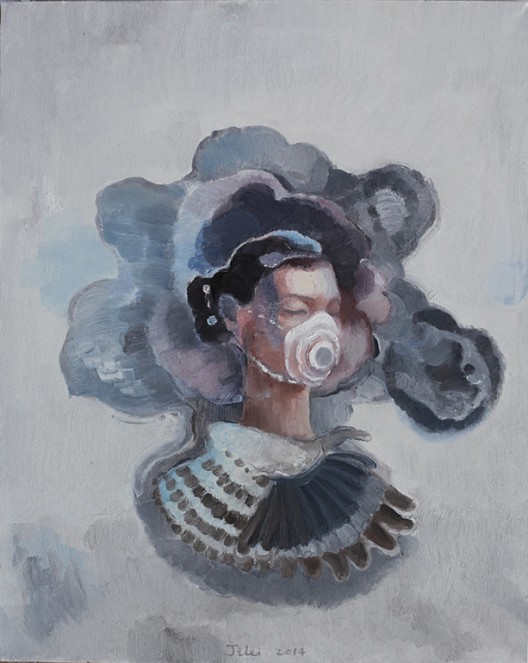
Ji Lei, “ Portrait for A Girl No.2”, oil on canvas, 100 × 80 cm, 2014
吉磊,《少女肖像no.2》,布面油画,100 × 80 cm,2014

